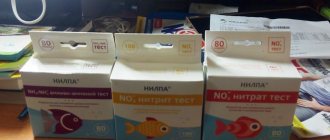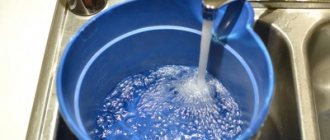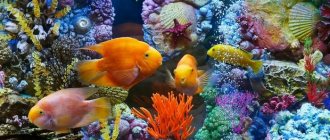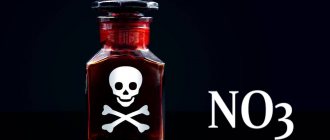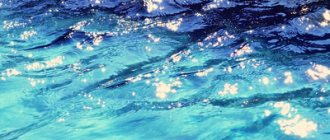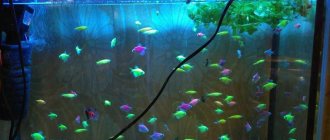An aquarium is a home decoration. A variety of fish and vegetation have an attractive appearance and energize the mood of those living in the room. However, problems often arise when the fish begin to behave passively and become susceptible to diseases. The cause may be hard water or accumulation of toxic substances. To eliminate the problem, it is necessary to identify the cause that disturbed the habitat. In such cases, special tests for water in aquariums are used. They can be of different types and prevent diseases at an early stage of development.
What tests are there to check the water in an aquarium?
As mentioned above, the ecosystem in an aquarium can quite often get out of control, which can create a serious imbalance in the normal functioning of the organisms inhabiting it. That is why it is recommended to carry out various water tests at least once a week for:
- Ammonia.
- Nitrates.
- Nitrites.
- Salt/Specific Gravity.
- pH.
- Carbonate hardness of water.
- Alkalinity.
- Chlorine and Chloramine.
- Copper.
- Phosphates.
- Liquefied oxygen.
- Iron and carbon dioxide.
It is especially worth noting that it is strictly not recommended to purchase each test separately, thereby significantly overpaying. The best option would be to purchase a full test kit. For a routine check, a standard kit will be sufficient. But if the vessel is intended for marine life, then it is recommended to acquire a special mini-kit. Currently there are:
- Test strips. Externally, this test looks like a small strip, which is where its name actually comes from, which must be lowered into a container with water from the aquarium. After this, all that remains is to make a visual comparison of the strip removed from the water with the list of colors in the set.
- Liquid tests. The second version of tests used to check the condition of water in an aquarium. So, to obtain results, you need to use a pipette to collect a few drops of liquid from the kit and drop them into a previously prepared container of water. After this, you need to shake the container a little and leave for a few minutes. Next, all that remains is to compare the resulting water color with the control value from the test set.
It is worth emphasizing that sometimes, in order to obtain independent results, it is recommended to involve a disinterested person. And in his presence, carry out all the necessary tests. It is also advisable not to tell him what a particular color means, but simply ask him about it. This approach will allow you to make the most accurate conclusions about the state of the water in the aquarium.
In addition, progress does not stand still and just a few years ago it became possible to find out some indicators, for example, pH, using electronic devices. It should also be noted that some tests are suitable exclusively for fresh water, and some only for sea water. Therefore, we will dwell in detail on the contents of some test kits.
Main types of tests
When choosing a suitable indicator for water, it is necessary to take into account the size of the container and the type of aquatic inhabitants. Tests can be of various types, each of which has features and advantages.
Stripes
Strips are an available type of test. The strips must be immersed in the liquid to the marked level. You can obtain the necessary information by comparing the color on the strip with the scale of acceptable indicators. The advantage of this method is its affordable cost. You can purchase indicators at a zoological store. However, to obtain accurate information, it is necessary to conduct repeated studies.
Note!
This testing method does not always provide accurate indicators and often does not detect harmful substances such as ammonia.
Test strips are the easiest and fastest way to check water quality
Drip
The drop method of water analysis is popular as it allows you to obtain accurate results. Drip tests are often used for aquariums. To carry out the procedure, it is necessary to mix the liquid with the reagent and compare it with the permissible values. The advantage of this method is the accurate result and the availability of kits in a specialized department. Unlike test strips, the drip method is expensive, but it allows you to eliminate toxins in a timely manner and protect the inhabitants of the aquarium from serious diseases.
Drip tests show the most correct result
Electronic
The electronic tester is expensive, but is used for containers with fresh or salt water. Using the device you can obtain accurate information in a short time. Electronic testers are divided into several types:
- pH meter - used for general study of water quality. It is very easy to use such a device; just set the necessary parameters and lower the pH meter into the liquid;
- TDS meter - a device used when it is necessary to obtain a more detailed analysis of water. Allows you to determine the amount of salts in a liquid, but requires regular calibration.
Using electronic indicators, you can obtain information in a short period. However, in order for the device to show accurate information, it is necessary to use special calibration solutions, which are difficult to find on sale.
Iron (Fe) test
Regarding myths about the suitability of some aquarium tests
For plant aquariums, the speech of JBL representative Heiko Blessin at a seminar for pet store sellers was very revealing for me.
He told the story that once upon a time no one bought their iron test. Then they decided to tell customers that the iron test is a fertilizer test. As a demonstration, it was proposed to drop fertilizer into a test tube, after which the test showed a very bright color of the test solution. And after this, sales of this test increased significantly. This is how myths are born among aquarists. In fact, the iron test
is completely unsuitable as a tool for determining the amount of nutrients in water for plants. In fertilizers, iron is partially or completely bound with strong chelates, which do not allow the drop test to correctly determine the iron concentration in an aquarium, but ensure the availability of iron for plants in the aquarium. And the iron in tap water, which can be determined by the test, is available to plants in very limited quantities due to rapid sedimentation. With this test, you can only determine whether or not there is iron in the water, as in the case of the experiment with fertilizers above. This test does not allow us to understand how much iron is available and how much it is available to plants.
Phosphate test
The phosphate test is not as bad as the iron test, but its readings should also be taken critically. The fact is that this test allows you to determine only the concentration of phosphates dissolved in water. But a lot of phosphates may be contained in the soil in the form of water-insoluble salts or organic compounds, which, for obvious reasons, this test does not determine. The phosphate test can only give an indication of the phosphate content in a new aquarium with neutral soil (pebbles or coarse sand). Over time, the soil silts and its phosphate content increases. The older the aquarium, the more phosphates are contained in the soil. The value of phosphates in sludge is that they are available only to the root system of plants and are not available to algae, as is the case with dissolved phosphates in water. In this process, bacteria play an important role, as a result of whose vital activity phosphates are dissolved and immediately consumed in the soil through the roots of plants. Another situation where the phosphate test can be confusing is when nutrient soils are used. Such soils can absorb phosphates from water, converting it into insoluble salts. At the same time, phosphates, thanks to bacteria, remain available to plant roots. And the phosphate test will show low values or even zero values.
Ignorance of the characteristics of phosphates described above and their consumption by plants has led to the fact that many aquarists began to add phosphates separately from other macroelements, trying to bring their concentration in aquarium water to some “ideal” value. In turn, this “ideal” value arose due to incorrect interpretation of the recommendations for the dosage of macrofertilizers (nitrates and phosphates). Often, dosages of nitrates and phosphates are recommended as the number of milligrams per volume of water in the aquarium that must be added per week. For example, the dosage of phosphate is 1 mg/l per week. But the mg/l dimension is also used to estimate concentration, for example, in the same test for phosphates. And therefore, many aquarists mistakenly perceive this as a recommendation to maintain a phosphate concentration in water of 1 mg/l.
Overall aquarium test
for phosphates may be useful for a herbalist, but it is not worth adjusting the dosage of fertilizers based on its readings.
Tested water parameters
If the fish and vegetation in the aquarium feel good, then experts do not recommend testing the water. Fitting the obtained data to certain indicators can have a detrimental effect on the inhabitants of the aquarium. For the most part, tests are needed for those who use fertilizers daily to assess whether there is an overdose. They are also necessary in a new aquarium with nutrient soil and in a tank with live plants. Diagnostics are also required when starting up the aquarium during the first month, when the system is just stabilizing. In the future, the water is tested not often, but regularly.
The values for which monitoring is carried out are divided into vital and minor, tested as necessary.
Basic values:
- ammonia and ammonium content (NH3/NH4);
- concentration of nitric acid salts (NO2/NO3);
- alkalinity and total hardness (KH/GH);
- acidity (pH).
NH3/NH4
At the start-up stage, as well as in a tank where the soil is very active or in problematic biological systems, when fish exhibit certain diseases, measurements of ammonia and ammonium content are mandatory.
In the process of life, the inhabitants of the aquarium release ammonia into the water, most of which, especially in acidic water, turns into ammonium. These two elements remain in water even when it is abundantly saturated with oxygen. Both are highly toxic. And if ammonia quickly worsens the health of fish, disrupting their breathing, then the effect of ammonium is longer, but just as deadly. Ammonium poisoning causes gill necrosis, which is very difficult to cure in fish. In addition, ammonium stimulates algae growth.
The ammonium content in acidic and soft water becomes even more dangerous. Indicator from 1 mg./l. - this is already a critical point.
To determine the presence of ammonia, take water from the reservoir (the amount is indicated in the instructions) and sequentially add reagents to it. Five minutes after the chemical reactions are complete, the test water will change color. The color of the water is then compared to a color chart and the concentration is determined. Most often, the normal level of NH3 and NH4 shows a light green color on the scale (0.3 mg/l). A concentration of 0.5 mg/l is a risk of tuberculosis, death of liver and kidney cells. An indicator of 0.6 mg/l serves as a signal to review the conditions of detention. In this case, it is worth reducing the number of inhabitants, or increasing filtration, or changing the food. When these chemical compounds are contained in an amount of 1.2 mg/l, fish show symptoms of acute poisoning, hemorrhage occurs, and the process of food digestion is disrupted. Measures are immediately taken to stabilize the situation, the result of which is monitored by testing.
Nitrate (NO3) test
There are no such peculiarities with nitrates as with phosphates, since nitrates are always soluble in water and do not accumulate in the soil. The test can be useful when caring for a planted aquarium with one condition - the test must be calibrated with a standard nitrate solution at least once a month. The big disadvantage of any manufacturer's nitrate tests is that over time they begin to lie. In the laboratory, to determine the concentration of nitrates, test solutions are prepared on the day of the analysis and in the following days these solutions are poorly trusted. Drip aquarium tests
have a stated shelf life of one year or more, but during this entire period they do not serve at the proper level. If you do not calibrate the nitrate test, then it can only be used to understand whether there is a lot of nitrate in the aquarium water or not, but it is not worth making any precise calculations, for example, fertilizer dosages.
Ammonia/ammonium test (NH3/NH4+)
The ammonium test is even more unstable than the nitrate test, and without calibration with a standard ammonium solution there is no point in using it at all. No matter what manufacturers tested for ammonium I came across, all of them, after calibration, were corrected not just by plus or minus 50%, but literally by several times in the direction of underestimating the actual indicators. Even in the first half of their expiration dates. If we talk about the use of this test in plant aquariums, then its use (of course, with preliminary calibration) makes sense only if you add large doses of ammonium salts as plant nutrition. After all, ammonium and especially ammonia are very toxic to living organisms, even in low concentrations.
Tests for the herbalist
Pet stores offer many tests for various purposes: to monitor water parameters in a freshwater aquarium, mini-reef, etc. In this article I want to evaluate the tests from the standpoint of their use in keeping aquatic flora.
Let me make a reservation right away: firstly, I do not advertise or criticize anything, but only share my subjective opinion based on personal experience, and secondly, the reader, of course, should understand that the gradation I propose is quite arbitrary, since every aquarist has your requirements for a pond with living plants. In everyday practice, the vast majority of tests are not needed at all. They should only be used to correct the light or as a safety net. For example, when for one reason or another the number of plants in the aquarium changes dramatically. Testing is also relevant when arranging a new reservoir in order to determine, say, the dosage of macro- and microfertilizers for this specific container in a given light, with given plants and a given number of inhabitants. Once the required values are found, there is no need for testing. Nevertheless, a certain minimum set of tools for determining the chemical parameters of water should be present in the aquarist-herbalist's household. And it must be formed thoughtfully so that, on the one hand, you do not waste money, and on the other, you do not end up without a useful test at the right time.
Necessary tests.
Long term CO2 test.
There are many options here, but the best, without a doubt, is
- a specially shaped small reservoir filled with an indicator liquid that changes color depending on the amount of dissolved carbon dioxide. It does not deceive and allows you to easily determine whether the rate of CO2 supply into the aquarium is sufficient, regardless of the supply method and the reactor used. I like the Dennerle drop checker. It is made of glass and looks aesthetically pleasing. I also prefer branded indicator fluids for filling the drop checker. Although they are more expensive, they inspire more confidence. How, tell me, can one rely on a certain con, which must be diluted with water in the required proportion before use, and it does not specify what quality it is. But it is known that for accurate measurements the test solution must have a fixed carbonate hardness (dKH 4). A branded package of indicator liquid, designed for 5 refills, lasts for at least a year (and taking into account the fact that with stable operation of the CO2 supply system and constant bubble counter readings, there is no need for regular testing, even longer). Therefore, looking at a bottle from an unknown manufacturer, on which it is written that the contents will last until the end of your life, remember: the stingy pays twice.
NO3 test.
Nitrate concentration is one of the most important indicators in an aquarium with live plants. If plants are deficient in nitrogen, they will stop developing or even die within a few days, so it is better to purchase a high-quality test for nitrates. I prefer the JBL set. It is the most sensitive, its scale is easier to determine the nitrate content in the aquarium, and, in my opinion, it is the most accurate on the market. The JBL test line is generally good. In addition to quality, they are distinguished by their cost-effectiveness: if the test solution runs out, you don’t have to spend money on purchasing a new kit, but simply buy the necessary chemicals. It will be cheaper (an option that other manufacturers do not have). But even an old woman can have a problem: not all JBL tests are equally good, but more on that below.
Test for PO4.
Like nitrogen, phosphorus is a macronutrient. There should always be enough nitrogen for plants, but by changing the concentration of phosphorus in the water it is possible and even necessary to control the growth rate of aquatic flora. Since I add a small amount of nitrogen to the water (which I recommend to other herbalists), I have to use a phosphate test more often to monitor the adequacy of the fertilizer dosage. After trying products from several manufacturers, I settled on Red Sea. Why this one? A better color scale, which means more accurate measurements. And the cost of the kit is somewhat lower, and this despite the fact that the contents are enough for 60 tests, while for most competing products this figure does not exceed 45. It must be admitted that I threw away my previous test for phosphates without using it to the end, because that the reagents have expired. But at that time I only had 2 aquariums and considerable experience in keeping plants. Some may require more frequent use, so this is not a plus that can be discounted.
KN test.
Of course, a pH test in an aquarium with live plants is more important, but since the water supply in most of Russia flows with hard water, and the values of carbonate hardness and pH are closely related, I decided to first consider the means of measuring pH. In fact, this test does not determine the concentration of carbonates, but the alkalinity, which is what we actually need. In any herbalist - with or without osmosis, with nutrient soil and with neutral quartz - control of carbonate hardness is mandatory. It is needed at least to have an idea of what you can expect... After all, the solubility of CO2 in water depends on the value of KH. Having compared competing products, comparing their quality and price, I preferred the SERA test. The color transition in the solution is brighter and more pronounced - that's one thing, the reagents are enough for a larger number of measurements - that's two. Even JBL lost in this competition. And SERA’s price is lower than similar tests from other manufacturers. Plus, as far as I understand, the Serov test has an unlimited shelf life.
pH test.
The most important indicator for plants. Therefore, the requirement for measurement accuracy should be maximum. After all, even deviations of tenths of the pH value sometimes lead to a significant difference in the amount of dissolved CO2. Hence the advisability of using high-precision electronic pH meters with an error of values up to hundredths. But these tools don't come cheap. What, then, should be the main criterion for drop tests? The answer is simple: the smaller the test measurement limits, the more accurate it is. And here at the top of the pedestal is again Red Sea with the narrowest pH measurement range among the pH tests offered on the market: 6.2-7.4. In most cases, this spread is sufficient for a planted aquarium. It should be noted that there is a good multi-colored scale that allows you to determine the desired value with an accuracy of 0.1. I didn't wet myself. The division value is 0.2, but the difference between colors allows for more accurate measurements. And the cost of the test is quite reasonable. The universal tests offered by some manufacturers with pH measurement limits in the range from 3 to 10 units, it seems to me, do not make sense to use not only for the herbalist, but also for any other aquarium, since their readings can be considered only very conditional.
Rarely used tests.
NH4 test. This test cannot be called necessary. Rather, it should be categorized as something that would be nice to have in your arsenal. Why? In a planted aquarium, plants compete with nitrifying bacteria for ammonium, and ammonium is usually not available. I would recommend this test only to beginners who are diligent in varying the diet of fish, preparing a varied menu for them, ranging from seafood to cucumbers and scalded cabbage and dandelions. Moreover, such luxuries often only cause increased stress on the biosystem. The first sign of this is residual ammonium in the aquarium after turning off the lights. In general, in a “bank” with living flora, the concentration of NH4 + in the evening must certainly be zero; if this is not the case, it means that the “plant + bacteria” complex cannot cope with the excess of incoming organic matter, and it is necessary to take measures to change the situation. The most common reasons for the appearance of ammonium in aquarium water are overfeeding or death of fish. I cannot recommend the manufacturer of the ammonium test, since I have not used it myself.
I use it. In an aquarium with a pH>7.0, nitrogen is in the form of ammonia (NH3), the toxicity of which for the inhabitants of the reservoir is several times higher than the ammonium form*. To monitor ammonia in alkaline water, Seachem has developed
Long-term test for NH3. Useful thing. Especially with high fish stocking densities. This test will warn you in time about the need for a water change and indicate ammonia concentrations that are dangerous for fish. According to the manufacturer, the service life of Ammonia Alert is 1 year. Can be used in both marine and freshwater “cans”. A significant disadvantage of the test is its high price.
A NO2 test is only needed when starting a new aquarium. As soon as nitrites are reset, you can introduce fish. If you don't want to measure anything, just wait longer. Usually the system “returns to normal” by the end of the third week. To speed up the “ripening”, you can fill it with water from an existing aquarium and carry out a daily “loading” of ammonium. In an old aquarium there are no nitrites ________________________________________________________________________________
*The test for ammonia nitrogen does not distinguish between the relatively safe ammonium (NH4 +) and the toxic ammonia (NH3) even in hundredths of a milligram, but shows their sum - total ammonia nitrogen. The proportion of ammonia in it can only be calculated (but not measured) using the formula NH3=x/10(9.3–pH), where x is the total ammonia nitrogen determined by the test, mg/l. – Editor's note
Read more on page 2.
Pages: 1
pH test (acidity)
Despite the fact that this is the simplest aquarium test
, it is the value of water acidity (pH) that has the most significant impact on the processes associated with plant growth in the aquarium. Whatever the values of nitrates or phosphates in your planted aquarium, if the pH tends to 8, you will not see good growth and appearance of most plants. This is a very common problem, especially in hard water. You can read more about the availability of plant nutrients depending on pH in the article about Diseases of aquarium plants. This is enough to classify this aquarium test as a “must have”.
When are tests needed and when not?
Tests are not necessary if symptoms indicating a problem are noticeable. It is necessary to take a closer look at the behavior of the fish and the condition of the aquarium. The problem can be identified by the following symptoms:
- if algae begins to grow rapidly, this indicates the presence of phosphates. Therefore, the test may not be performed;
- if the algae has turned yellow and the fish are sedentary, this indicates a lack of iron. To eliminate the problem, you need to use special feed with an increased amount of iron extract;
- After using medicinal substances, it is necessary to purify the water from excess copper.
Professionals in breeding aquarium fish note that all aquarists should have a basic set of tests. Since external symptoms may overlap. Mandatory testers should include KH, pH, GH, PO4, NO3. Other types are purchased as needed.
It is important to have all the necessary tests in place before starting the tank. Fish are not placed in new water until all necessary tests have been completed. Otherwise, aquatic inhabitants may die or take a long time to adapt to the new environment. It is also important to test in aquariums that contain a large amount of vegetation.
A basic set of tests is always needed
KH test (carbonate hardness or alkalinity)
Aquarium test
To determine carbonate hardness, KH (or more accurately, alkalinity) can allow you to understand why your planted aquarium has a high pH. Since the higher the KH of water, the higher its pH. An experienced user with a KH test does not even need an acidity test to understand whether his aquarium water has a low or high pH. For example, in water with a pH of 15 degrees, the pH will be above 7 and sometimes significantly higher. Also, using pH and KH tests, you can estimate the concentration of carbon dioxide in water using a special table.
Why do tests?
Aquarium tests evaluate water quality. Some of the diseases that aquarium inhabitants are exposed to occur due to poor living conditions. Thanks to special indicators, it is possible to identify toxic substances and prolong the life of fish. Tests help identify toxins, increased water hardness or acidity in the aquarium.
Before starting an aquarium, you need to know all the details
GH test (general hardness)
For a planted aquarium, testing total water hardness is not as important as testing carbonate hardness and pH. As is correct, the total hardness is several degrees higher than the carbonate hardness and it does not affect the pH values. But there are rare cases when carbonate hardness is higher than the general one. This happens when carbonate hardness is caused by high levels of sodium and potassium carbonates in the water. It is in this case that it is most correct to say alkalinity, rather than carbonate hardness. It is very difficult to keep aquarium plants in such water. Therefore, in practice, the GH test is only needed to determine whether the total hardness in water is too low compared to carbonate water.
How to choose the right type of test correctly
In order to choose the right test for your aquarium, the following criteria must be taken into account:
- It is not recommended to use budget testers. Such products do not always provide accurate information. Therefore, preference should be given to proven brands;
- choose testers with small increments. Such devices allow you to obtain accurate information in a short period;
- depending on the problem. If aquarists are able to independently determine the problem, a tester is purchased to identify the element causing harm. If the problem is not identified, combination kits are used.
Among the range of testers, it is necessary to highlight manufacturers who have positive reviews from users:
- Tetra. The manufacturer offers kits for analyzing water in an aquarium. The kit contains all the necessary tools for testing. In addition to the necessary tests, the kit includes recommendations on indicators that are necessary for the normal development of aquarium inhabitants.
- Sera. The company offers a selection of strips that allow you to determine water hardness, acidity, and the presence of nitrites and nitrates. The strips are easy to use and give accurate results.
- JBL. The manufacturer offers professional reagent kits. Using the drip method, you can quickly identify the problem and take the necessary measures.
- AQUAXER. If you need to carry out continuous testing, you should pay attention to this brand.
- Ptero. Comprehensive kits that contain all the necessary tests for a full analysis of the liquid.
On a note!
If choosing a test yourself is problematic, you need to contact an aquarist who will help you choose the required species.
You can find products on sale in different price categories
What to do after diagnosis?
If tests show any abnormalities, the first step is to ensure an influx of fresh, clean water. Options for how to do this:
- If the situation persists, then you can stand the tap water for three days.
- If this needs to be done urgently, then you can quickly prepare the aqua like this:
- clean with a household filter without silver, heat to the temperature of the aquarium, aerate for an hour, measure the acidity, and adjust it if necessary;
- Bring the water to a boil, cool, and aerate for at least an hour.
Next, replace a third or a quarter of the liquid in the aquarium with water prepared in one of these ways.
- Refresh the water with special purchased reagents to quickly neutralize harmful impurities.
